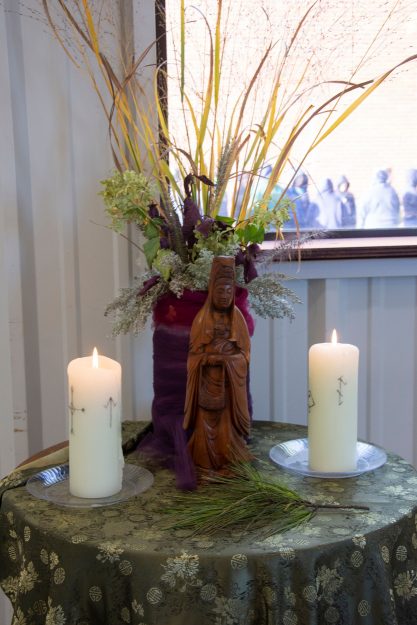For decades, initiatives like the Prison Dharma Project have brought meditation and Buddhist teachings to incarcerated people across the country, but the image of the inmates who participate in these projects remains almost exclusively male. Yet inside at least one women’s prison, a tradition of Buddhist practice has emerged and continues to grow. On October 17, Kerry Vadasz and Erica Orta, two inmates at the Ohio Reformatory for Women, joined that tradition when they received the 16 bodhisattva precepts, in the fourth jukai ceremony held at the prison since 2012.
Ordained Buddhist chaplain Katie Egart of the Yellow Springs Dharma Center has been volunteering at the Marysville, Ohio, prison since 2011, after Laura Taylor, who has been serving a life sentence since age 17, asked the prison chaplain to put her in touch with a Zen Buddhist teacher.
“The chaplain called me and said, ‘I have an inmate who wants to ordain as a Zen Buddhist nun,’” Egart told Tricycle. “When I met Laura, I explained that I practice in a Zen tradition where lay people can take formal precepts. It turns out you can’t ordain at this prison.”
Laura’s interest in Zen led to the formation of a weekly sitting group. “I brought in cushions and we got permission for Laura to have a zabuton and zafu in her cell. Then more and more women started to join us,” Egart recalls. “But Laura is really the founding mother—it was her interest in Zen Buddhism that was the catalyst for my coming in there.”

A year later after she began formal Zen study, Laura became the first woman at the reformatory to take the 16 precepts: the three treasures of taking refuge in the buddha, dharma, and sangha, the three pure precepts of not creating evil and practicing good for oneself and others, and the ten grave precepts which promote non-harming and ethical conduct.
Laura and the students still face many challenges to their practices. In the months leading up to a jukai ceremony, Zen practitioners traditionally sew a rakasu, an apron-like garment that one wears to signify that one has taken the precepts. But getting a needle was difficult.
“At first, they insisted that Laura leave her rakasu in the chapel,” Egart said. “We had to count the needles going in and out, and I had to bring the needles every time, too. Things have gotten a lot better since then. There is a lot more trust, and the women can work on the rakasu outside of their cells.”
The Ohio Reformatory practitioners in their own words: read an interview with Laura, Kerry, and Erica in Tricycle’s Summer 2020 issue.
Formal Zen students also are expected to attend at least one or more sesshin, a silent retreat, and participate in private meetings [Jpn., dokusan] with their teacher for counseling and encouragement. In prison, these retreats are impossible.
While the stringent regulations create extra hurdles for the Ohio Reformatory practitioners, Laura has helped lay the groundwork for later students. Laura had to work closely with Egart to create her rakusu, for instance, because she had no model to emulate. “But now Kerry and Erica can look at hers, and she can show them how to do it,” Egart explained. “They have an elder who has been through this before.”

Roshi Daniel Terragno, who teaches at the Rocks and Clouds Zendo in Sebastopol, California, and the Yellow Springs Dharma Center in Ohio, led the jukai ceremony at the prison chapel.
After Roshi Terragno read each precept aloud, Kerry and Erica expressed, in their own words, what the precept meant to them personally. For the past year, Egart had worked through a curriculum with them, focusing on each precept one by one. Their syllabus included Taking the Path of Zen by Robert Aitken, Waking Up To What You Do by Diane Eshin Rizzetto, and Koshin Paley Ellison’s Wholehearted.
“Once you spend time with each of the precepts, they open up lots of areas of your life,” Egart shared. “For instance, think about the precept of not killing. Very simply, that would mean not taking life, but then you start to ask, ‘What is life? And am I killing other people’s ideas in my interactions with them?’ It’s a very self-reflective process.”

Outside of formal precept study, Egart also holds an informal Zen meeting group every week for the women at the reformatory, which includes sitting and walking meditation and a sutra service.
“The women ask questions, and those questions often lead to little dharma talks. When I first started going in there, I used to think, ‘Today, I’m going to talk about this,’ but I soon realized that that was completely pointless; I have to go in empty, because I have to respond to whatever situation they’re dealing with.”
Since meeting Laura, Egart has helped four women take the precepts at the Ohio Reformatory, and has found the experience deeply rewarding.“People will often say to me, ‘Wow, you go into the prison.’ That’s not a big deal, though. What is a big deal is the women who have established and made a commitment to a practice. It’s not easy for anybody to have a practice, much less in a very concentrated, controlled environment. What they’ve managed to do is remarkable.”
Thank you for subscribing to Tricycle! As a nonprofit, we depend on readers like you to keep Buddhist teachings and practices widely available.
